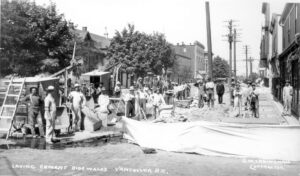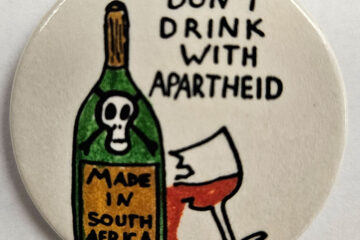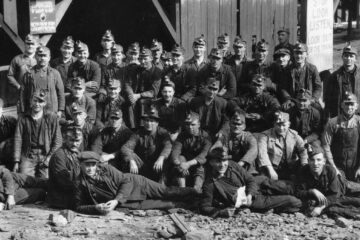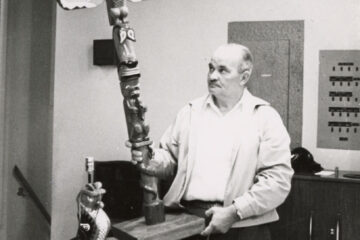The Italian Labourers’ Strike, July 1910
by Jak King
Reproduced with permission from Grandview Heritage Group
Originally published November 10, 2022

Photo supplied.
The summer of 1910 was a hot one for labour across North America. In the first couple of weeks of July, more than fifty thousand garment workers went on strike in New York in a dispute that would eventually draw in more than 100,000 workers; bricklayers and stonemasons walked off the job in Montreal; 11,000 of their brethren were threatening strike in Iowa; 1,500 carmen on the CNR struck; miners and police in Nova Scotia exchanged gunfire; and machinists in all the US Pacific states and British Columbia were in the middle of an extended shutdown. It was impossible to read any metropolitan daily in Vancouver in those weeks without being faced with story after story of strikes and disputes.i
Vancouver that summer was in the midst of a rapid expansion, development, and building boom, with new and old streets being created, improved, and paved using the labour of both city employees and those who worked for private contractors. One of the largest of these contractors was M.P. Cotton & Co which had the contract for laying sidewalk paving along Venables Street in Grandview. They employed a great many Italian labourers in their projects. At 10 o’clock on the morning of July 18, 1910, “sixteen of the Italians dropped their tools and refused further work” and demanded that Cotton pay them $2.70 for an eight hour day, the same rate as the city employees were being paid.ii
“As soon as they had quit .work, they proceeded a little farther east along the same street and. accosting some Italians, about seven in number, who were working for the city, ordered them to go oil strike, in sympathy with their difficulty; This the latter at first refused point blank to do. The strikers then threatened that they would kill them unless they obeyed. The city foreman meanwhile telephoned for the police, but before the latter arrived the rest had thrown down their tools and gone away with the contractor’s men. Leaving Venables street the gang repaired to Robson Street, where they compelled more Italians to quit work.”iii
The racist element of the press quickly made an issue of nationality. The Vancouver Daily World was happy to repeat the conspiratorial bigotry of “a prominent businessman” who claimed to have recognized three of the Italian labourer leaders as having been agitators in Port Artrhur and Bradon years before “which almost developed into a race war” before it was settled. He called the strikers “a gang of undesirables”, and they noted
“The great difficulty with which the police have to contend is the fact that they do all their talking to their fellow countrymen when inducing them to quit work in their native language. If their threats could be understood by a white man they could be promptly arrested.”iv
The reporting during the second day of the strike was decidedly dramatic, featuring “gangs” of Italians systematically intimidating workers on city sites. One gang of more than 200 labourers was said to have threatened “butchery” against any English labourers they came across, been armed with knives, and threatened to kill Cotton’s foremen who had come out to work at Kits beach.v
Vancouver City Council, which was meeting that day, passed a resolution allowing city contractors to work their men forty eight hours a week between 7am and 6pm. Mr. Cotton reported to Council that all his workers on city contracts had quit work the previous day. The spokesman for another contractor, Palmer Bros and Henning, told the aldermen that their workers at the Cambie Bridge site had been approached by the Italian “gang” and forced to stop work. Alderman White repeated a rumour that the sewer workers were hoping the labourers’ action would kick off a general strike. Cotton stated that he thought the 8-hour day was a recipe for disaster, while Mayor Taylor laid all the blame on Cotton for working his men 9 hours when the City contract had an 8-hour clause.
Police were sent to a site at Westminster and 13th where trouble was expected, but the mob walked over to Kitsilano instead. Preceded by about thirty strikers on bicycles, the mob of about one hundred travelled on to Robson and Burrard where more than 50 sewer men working for T.R. Nickson refused to join the strike. Their argument sounded like
“the confusion of tongues at the Tower of Babel. Swarthy Italians were trying to make themselves understood, Irishmen and Swedes … were voicing their opinions of all Italians in general and vowing to have the whole gang arrested if they did not go away.”
Eventually, a foreman persuaded the strikers that the sewer men were already being paid $2.70 and so had no incentive to join the strike. The crowd moved on to Mount Pleasant to look for more workers.vi
Oddly, perhaps, the Vancouver Daily World describing the third day of the strike headlined that the “strikers kept their good humour.” They began their coverage by noting that strikers are “giving very little trouble to the police” and that the day promised “to be as quiet and orderly as the first two days.” On this third day, the Italians gathered downtown at 7:30 in the morning “in as much regalia as they could gather”, and carrying placard specifically calling for an 8 hour day and 35cents an hour. They marched to Pender and Richards where the BCER had a gang of Italians laying sctreecar tracks. The mob eventually persuaded most of the workers to lay down their tools and join the march. The enhanced group traveled to several other work sites, picking up support as they went, and then they made their way to City Hall where a delegation was already meeting with City Council.
The workers’ delegation had asked the Council to mediate their demand for 34 cents an hour, but a number of major contractors had refused, and offered 31 1/4 cents per hour. The Mayor told the strikers that in his opinion the strike was a mistake and they should have come to him with their grievances. vii
However, he was careful to observe that most City employees did not get the rate the strikers were seeking:
“Common labourers were receiving 31 1/4 to 34 cents an hour, the former for working on the level, and the higher scale for those working in trenches. Pipe layers and timbermen were receiving 36 cents, which is infinitely harder work.”
That afternoon, Italians working for contractor Hartney at the Richards Street carline extension, who had laid down tools in the morning in sympathy with the strikers, said they were happy to go back to work. They were being paid 35 cents an hour and had only joined the strike to honour their countrymen.
Led by a cyclist blowing a horn, about a hundred strikers along with a mounted detachment of police arrived at Granville & 4th where Cotton had a sewer contract. After “much noise and gesticulating,” all the Italian workers walked off the job leaving one English worker who “refused to be dictated to by Italians” to be protected by the police.viii
That evening, the mass of the strikers gathered at Carroll & Cordova where fiery speeches were given and applauded. Reviewing the day’s events, the Province wrote:
“It is a matter of wonder … that a clash has not occured yet between the Italians and the authorities. All yesterday afternoon calls were pouring into police headquarters from different parts of the city where the foreigners had gathered in gangs to stop if possible the other workmen from sticking by the contractors. Mounted constables and patrolmen, setrgeants and detectives were on the go the whole day attending these different scenes of possible riot.”ix
The next day, July 21st, the strikers met early in the morning at Venables and Park Drive and marched to Napier Street where Cotton had workers on a contract. The workers refused to join the strike and the strikers “made their first vicious demonstration. Several guns and knives were displayed, accompanied by threats to annihilate all who opposed their efforts.” The police, who were waiting close by, arrested the man, a young Irish-American named Joseph Weir, they considered the leader and hoped that would keep the crowd quiet. Weir was an activist with the Industrial Workers of the World (I.W.W.) and wore an IWW button. His arrest was the signal for shouts of “Rush the police”, but the detectives held their ground.
The “foreigners,” as the Daily News Advertizer insisted on calling them, moved to a vacant lot where they quickly elected another man to be leader who they furnished with a trumpet. This new leader immediately ran into the forest to the east and disappeared. Soon after, a series of blasts from the trumpet in the forest led the strikers to Lakewood & 7th where they persuaded about 30 men working for Minto & Toto to join them.

Photo supplied.
By now, the strikers were being accompanied by a whole cordon of police. The march proceeded to Lakewood & 12th, crossing the GNR Cut through which the mounted police could not follow. Finally, they gathered at Victoria & 12th to discuss where they should go next. They marched west to Main Street, turned south to 18th & Manitoba where they failed to attract the support of some South Vancouver workers. By the time they arrived back at Main & Broadway, the effects of the long trek were taking their toll and the marchers dispersed.x
In the meanwhile, a group of contractors was looking to hire scab labour. They had heard of a group of about 600 Galicians and Hungarians in Montreal who might be persuaded to move out west. Cotton, in particular, was clear that he had no intention of hiring back some of the men he considered most troublesome.xi
In an editorial on the 21st, the Province, while admitting that the labourers’ strike had not caused too much turmoil, declared that the strike needed to be suppressed for the sake of setting an example. They revealed their own prejudices when they declared that the strikers
“are all foreigners who have no conception of the sanctity of agreements between employers and employees; who are utterly without any idea of the spirit of fairness … They should be taught sternly that the law is supreme.”xii
The following morning, Friday 22nd July, a group of strikers was assembling on Barnard Street in Grandview when Sergeant McLennan and two detectives swooped in and grabbed Allisio Santarelli. When pressed by the crowd as to why Santarelli had been arrested, the police said that this was their new plan — to arrest all the strikers one after another. This, apparently, was enough to persuade many of the strikers that their jobs were on the line, and that afternoon foremen reported a significant increase in applications for work, any work; and essentially the strike was over.xiii
In a final act of defiance, about 60 Italian strikers went to one of Cotton’s sites at 4th & Vine and demanded the workers join them. But the workers refused and seemed prepared to attack the strikers with their shovels and pickaxes. Just as a foreman took out a gun, the police arrived and ordered him to put it away. The strikers dispersed.xiv
Joseph Reid and Allisio Santarelli were both charged with intimidation and each was given $200 bail. In the end, Santarelli pled guilty to riding his bicycle on city property and paid a fine of $2. Reid, on the other hand, went to a trial where he was found guilty. His sentence was a $25 fine or fifteen days jail. He took the jail time.xv
i NY garment workers: Province 1910 July 8, p.1; Vancouver Daily World , p.23; 12, p.21; Daily News Advertizer, p.1; 10, p.6; 12, p.12; Weekly News Advertizer July 11, p.1. Montreal bricklayers: Province 1910 Jul 4, p.8; Daily News Advertizer 5, p.10; 6, p.1; Vancouver Daily World , p.10; Saturday Sunset 16, p.9. CNR carmen: Province 1910 Jul 8, p.26; Vancouver Daily World , p.24. Miners in NS: Vancouver Daily World 1910 Jul 8, p.15; Province 11, p.1. Iowa builders: Vancouver Daily World 1910 Jul 9, p.1; Machinists: Daily News Advertizer 1910 Jul 3, p.1; Province 4, p.8; 7, p.14; Vancouver Daily World 6, p.1; 9, p.16; 18, p.25.
ii Cotton had been paying $2.42 for a 9-hour day the year before. Once the 8-hour day bylaw passed he paid $2.50 for an 8-hour day, and $2.70 if 9 hours were worked. Just as the strike started, Cotton raised the rate to $2.56 per day. Province 1910 Jul 19, p.11.
iii Vancouver Daily World 1910 Jul 18, p.19
iv Vancouver Daily World 1910 Jul 19, p.1, 2
v Vancouver Daily World 1910 Jul 19, p.1; 20, p.2; Province 19, p.11
vi Province 1910 Jul 19, p.11
vii Vancouver Daily World 1910 Jul 20, p.2; Daily News Advertizer 21, p.1, 9
viii Vancouver Daily World 1910 Jul 20, p.2; 21, p.2; Province 20, p.8; Daily News Advertizer 21, p.9
ix Province 1910 Jul 20, p.8
x Vancouver Daily World 1910 Jul 21, p.2; Province , p.1
xi Province 1910 Jul 21, p.1
xii Province 1910 Jul 21, p.6
xiii Vancouver Daily World 1910 Jul 22, p.1; Province , p.1
xiv Vancouver Daily World 1910 Jul 22, p.19
xv Vancouver Daily World 1910 Jul 29, p.18



